Selecting an inshore bayfishing rod is not too difficult. These rods are called “bayfishing or “bay” rods, because they are typically used in the bay, but are also called “popping” rods because they are commonly used to fish popping corks. Most Academy or Dick’s Sporting Goods locations near the coast have a variety of them to pick from. If you are in the Corpus Christi, Texas area, Roy’s Bait and Tackle is the premiere outfitter for higher end, quality rods.
The typical bay rod is extremely versatile. It can be used to fish live or dead bait, either freeline, on the bottom, or under a popping cork (a very popular method). It is light, sensitive, and easy to cast, so it can also be used with a wide variety of lures, and is not too heavy to cast all day long. My bay rods are used for nearly all of my wadefishing and kayak fishing situations, and for about half of my shore fishing situations. There are a few characteristics to be aware of when selecting a rod, so I will discuss that next.
Bay Rod Specifications and Characteristics
Here are some general specifications for an inshore bay rod:
- Has a length of 6.5 ft to 7.5 ft
- Medium to Medium-Heavy action
- Made of graphite
These general specs have been around for a long time and are widely accepted by the fishing community. However, there are a few particulars that you will want to keep in mind.
First, the rods intended for spinning reels are slightly different from the rods intended for baitcasting reels. Rods for spinning reels have “large” eyes near the reel seat, while rods for baitcasting reels have “small” eyes near the reel seat.
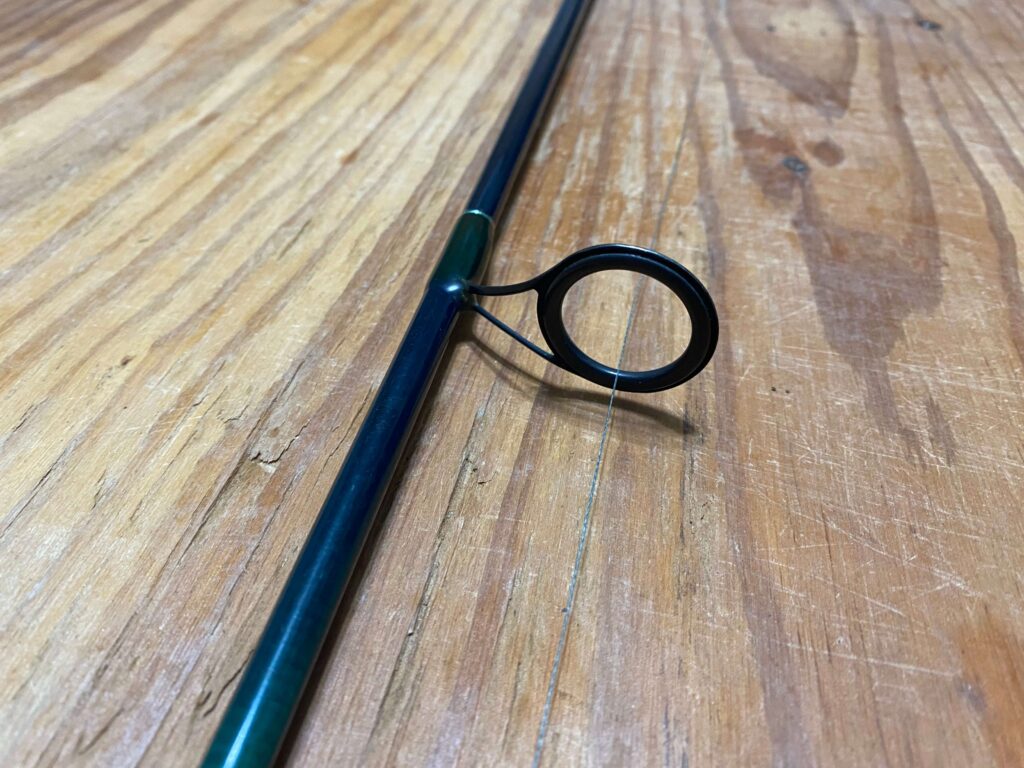

The reason for this is that fishing line requires more room as it leaves the open face of a spinning reel (i.e. the line oscillates), hence the larger eyes on a spinning rod. Baitcasting rods have smaller eyes because the line doesn’t oscillate; it remains confined within the level wind mechanism at all times.
So…make sure to pick the rod that suits the reel (spinning or baitcasting) that you plan to use.
A Bit of Tip Flexibility
Different rods have different “power” and “speed” characteristics. These ratings are typically printed on the thick part of the rod (above the reel seat) by the manufacturer. For example, a particular rod may have a listed power of “medium-heavy” or a speed of “extra fast”. These ratings be quite confusing because different manufacturers can use slightly different terminology, and to my knowledge, there is not a uniform standard for these characteristics. Although, generally speaking, a medium-heavy rod from one manufacturer should be similar to a medium-heavy rod from another.
I like to keep things simple, of course, so I evaluate a rod to see if it has the stiffness or flex characteristics that I feel are acceptable. I pay particular attention to “tip flexibility”. If you are just starting out, or if you plan to fish mostly with bait, I wouldn’t pay much attention to this. For example, I can fish a popping cork or fish-finder rig on any of my rods without any issues. If you fish with lures, you will want the flex characteristics to match the type of lure fishing you plan to do. But don’t worry if you get it wrong. This part takes a little experience (and is largely personal preference, as well), so you will learn what you like as time goes on. Generally speaking, most lures, especially those that you have to pop, are easy to work when the top two feet of the rod are just a bit flexible (not to stiff and not to floppy). You can get a sense for the tip flexibility by holding the rod in one hand (without the reel or line) and lightly whipping it in the air.
Quality
I can’t easily recommend a brand or model of rod at the current time, because it is quite hard to see through all of the marketing hype. From a few feet away, a $50 rod and a $300 rod will both look nice because they are brand new and haven’t been beat to hell yet. Each rod will likely have a tag from the manufacturer that advertises the particular rod’s “technology” or construction method. To a beginner, this won’t mean much, and a lot of it is just advertising anyway. Now, we hope that a $300 rod is better than the $50 rod. Usually, a more expensive rod is more sensitive or has better action, but “how much better” is not usually known, and sometimes we are paying for a brand name or simply buying based off of reputation. It also doesn’t mean that the $50 rod is a bad rod. Other than price, the consumer actually has little information as to the actual design, build quality, or construction methods used, unless they happen to have done a lot of research. Rods that are made overseas, and those that are made in the USA (if any) will probably look and feel about the same in the store. Since we don’t work in the factory, we don’t know if the workers that construct the rods have any actual knowledge of fishing or the demands it entails. We can’t easily see the graphite fibers at magnification so don’t know how they are laid up or glued together, and we can’t easily judge the quality of the components that are attached to the rod, like the eyes and reel seat. My recommendation is to pick the one you like based on feel, and you can upgrade later once you figure out what you like. Also, keep in mind, all graphite rods ( “el cheapo” rods, mid-range rods, and expensive rods) can have the tips snap or break off, because graphite is fragile if you abuse it or aren’t careful.
Rods That I Use
Although I can’t easily recommend a rod, I can show you some of them that I use/have used, and my thoughts on them. Hopefully this will make your selection process easier. I wouldn’t recommend trying to buy the same model, because some of these are not longer being produced. But I think the rods specifications will be useful for you.
St. Croix “Tidemaster“

Specs:
Model TIS76MM, 7′ 6″ long, moderate action, graphite
Use:
I use this rod for nearly all lure fishing with a spinning reel (a Daiwa BG 2500), using 20 lb (6 lb equivalent diameter) braided line. At 7.5 feet, this is the longest bayfishing rod I own. Years ago, I wanted to set up a rod/reel combo that could cast small lures long distances, in order to catch trout and redfish any time the bite is finicky, without being detected. This rod, combined with braided line and a modern spinning reel, will absolutely launch a smaller/lightweight lure. I have caught untold numbers of trout, reds, and drum (even a couple of oversized drum) on this rod, and it’s still going strong. It is not a stiff rod; it has quite a bit of flex all the way down to the middle section of the rod, so this rod is my go-to for light lures that you “crank”, like swimbaits and spoons. It is not my top choice for lures that you work or pop a lot. For those types of lures, I use the next rod, below.
All Star “Zell Rowland Signature Series“
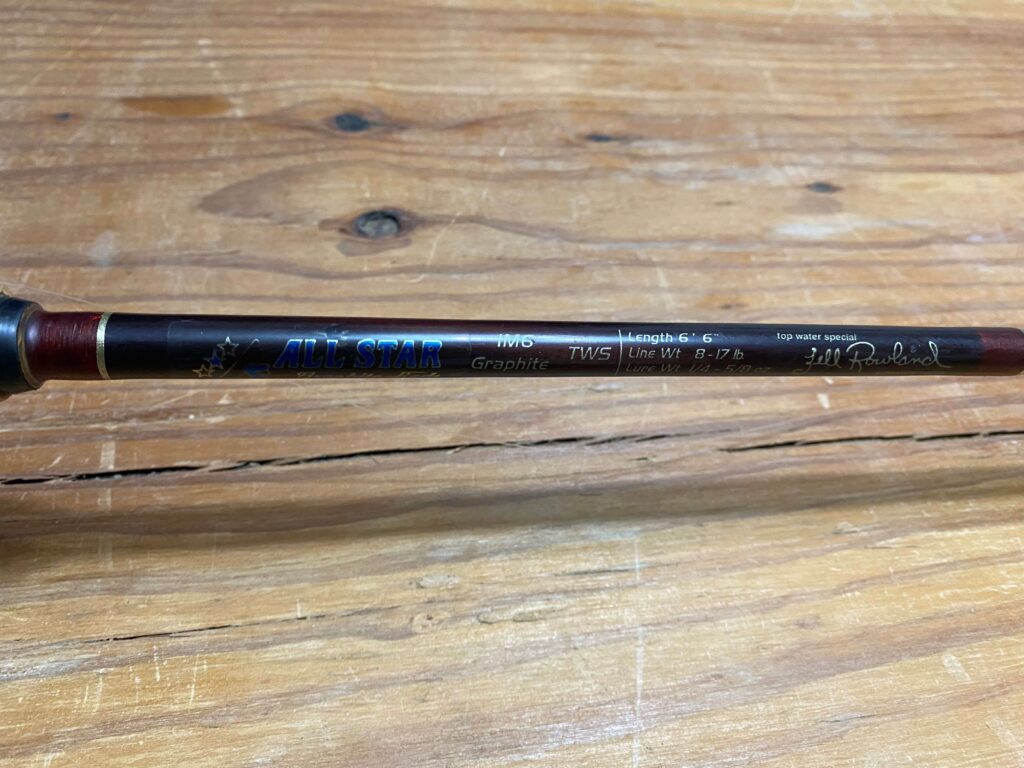
Specs:
Model TWS “Topwater Special”, 6 ft 6 in long, graphite, action not listed.
Use:
This is currently my go-to rod for all lure fishing with a low-profile baitcaster (a Shimano Curado), using 10lb monofilament line. It works great fore nearly any type of lure fishing (in my opinion), because it has just the right amount of tip flex. I use this rod for lures that I have to work or “pop” quite a bit, like topwaters, jerkworms, etc. Just a great rod for a baitcaster. If I need to switch to live or dead bait, it can do that just fine too.
All Star “Classic Series“
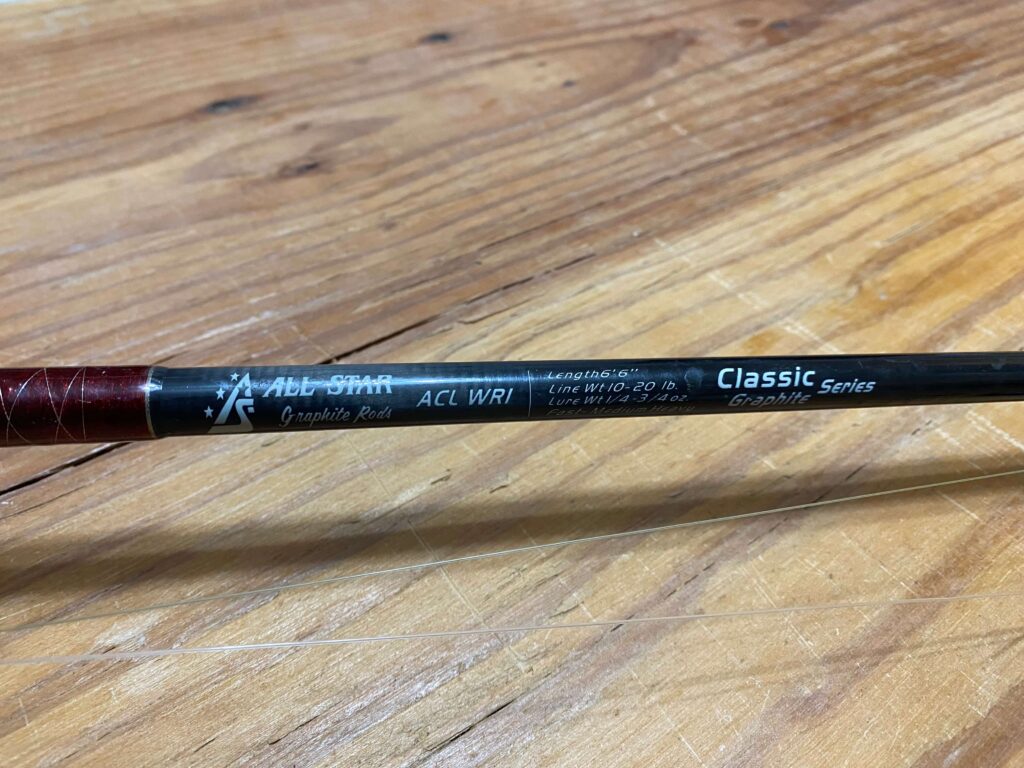
Specs:
Model ACL WRI, 6 ft 6 in long, fast-medium heavy, graphite
Use:
I use this rod with my round baitcaster (an Ambassadeur 6500 C4), using 15 lb monofilament line. This rod is a hare thicker than my others, and is quite stiff all the way to the tip. It is capable of handling larger fish, and is well-suited for bait fishing with the Ambassadeur (I’ve caught many oversized drum on this setup without any problem; it whips em’). Due to it’s stiffness, I rarely use this rod with lures, although I could in a pinch.
Okuma “Epixor“

Specs:
Model EPi-S-701M, 7ft long, graphite, action not listed
Use:
This is my son’s rod, and I bought it for him a few years ago at Dick’s Sporting Goods. He uses it with a Pflueger President spinning reel, and mostly uses it for both bait fishing and lure fishing with 10lb monofilament line. So far, it works great! For the price at the time (around $50 from what I remember), it has been great and I would love to pick up another one at that price. Unfortunately, the universe decided to throw a curve ball….last time l looked the price had increased over 50%, and I guarantee you that there hasn’t been a 50% increase in quality. I believe in voting with my wallet, so this is a hard “NO”. Instead of getting my $50 dollars, Dick’s will get $0. You’re welcome!
American Rodsmith “Genesis“
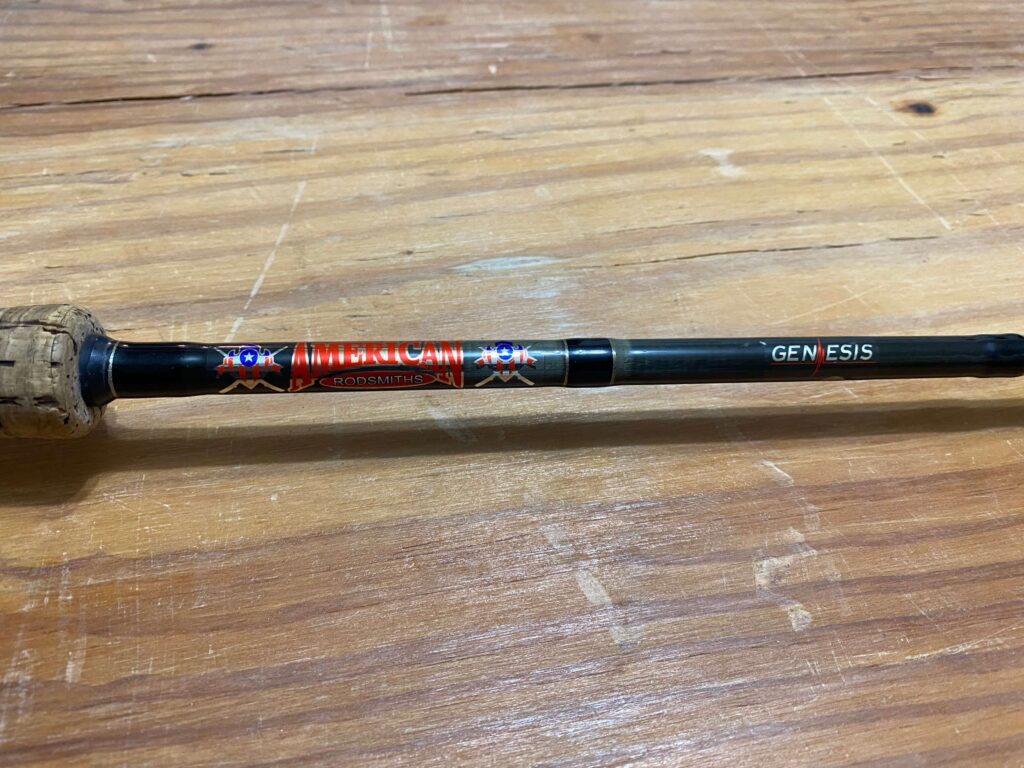
Specs:
Model ARS-MP7 “Titanium Series”, 7 ft long, graphite, lure weight 3/8-3-4 oz, line weight 8-17 lbs. Action not listed.
Use:
I have temporarily retired this rod due to a crack in the reel seat, after many years of hard use catching inshore trout and reds. At some point, I plan to refurbish it and may do an article on that. This was my go-to rod for all lure fishing with my low-profile baitcaster (a Shimano Curado), due to just the right amount of tip flexibility. It has now been replaced by the All Star rod discussed above. I fished this rod/reel with 10lb monofilament line.
You Need A “Big Rod”
No, you really don’t, at least not for wadefishing and kayak fishing on the open flats/bay. The “bay” rods mentioned above work just fine for wade/kayak fishing. For shore fishing situations, you may or may not need a bit of a beefier/longer rod, depending on your situation and size fish you are targeting. For example, if you are fishing dead bait in the calm waters of harbor, using only a small egg sinker to cast and keep the bait down, just about any bay rod will work fine for this. But, some shore fishing situations are more challenging than this. For example, you may need to cast heaver weights (2 oz or more) to to mitigate waves and strong currents like in the surf or at the jetties, or to get more distance if the fish are feeding far from the shore. Or, maybe you are targeting big, powerful fish, and you need a rod that has a lot of “backbone” (i.e., power). Powerful rods certainly have a place when trying to catch oversized drum, jack crevalle, sharks, or other large, powerful fish. I plan to write another article in the future that discusses how to pick beefier/longer rods for these types of situation.
I think sometimes beginners and the uninformed think they need a big rod for “big” fish, but this argument is only somewhat valid, and generally speaking, I think they would do better to pick a bay rod over a beefier rod, unless a beefy rod is specifically required. For example, I can catch any slot sized redfish with any of the rods mentioned above, with zero problem. And what if I accidentally hook an oversized fish? Well, I have done that on a few occasions, and while not ideal, I was still able to land those fish. I frequently see people fishing off of the Corpus Christi T-heads and and the JFK Causeway with overly beefy, thick rods, and reels that are too big also. Those rods are better suited for the jetties, but are quite overkill for the protected waters of the harbor. What do they plan to catch, Jaws?
My recommendation for beginners is to stick with rods of similar specs to those mentioned in this article, and leave the beefy rods at the store, until you have a specific fishing situation that requires them. None of the bay rods mentioned here have a thickness over 1/2 in thick at the base, and some are a bit thinner. Bay rods are highly versatile, and they are a pleasure to fish without being too beefy or too wimpy. Smaller fish will put up quite a tug and large fish will put up a hell of a fight, but all are catchable at the end of the day. One big perk is that bay rod are easy to cast, and are an easy way to learn lure fishing if you desire to do so.
You Need Multiple Rods
No, you really don’t. Many experts online and elsewhere will say that you need multiple rods, each selected for specific lure weights (or lure types), and that you need the power and speed of the rod tailored to the conditions/situation. These discussions can get really scientific and overly complicated. Technically, they are right! You should match your rod to your conditions, lures, fish, etc.
But, I have a few counter arguments:
- First, folks that preach these things are typically partnered or sponsored by the various brands. Enough said on that.
- Second, fisherman have caught fish for eons with gear that was much, much worse than the choices that are available now. And they still caught fish, and plenty of big ones. Gear was crude, heavy, less sensitive, less advanced, and yet people caught fish. They caught fish with rods/poles made from wood, bamboo, spring steel, fiberglass, you name it. I’m not suggesting that you have to use this old stuff, but what I am suggesting is that choosing one or two good bay rods can accomplish just about anything that you need to in the bay. No, your rod won’t be perfect for every situation, but you can learn to adapt it to any situation, even if it is not ideal.
- Third, unlike a boat, you have limited space when kayak fishing and wadefishing, and carrying less just makes things easier. My recommendation is carry no more than two bay rods at any time. This way you always have a backup in case one breaks, but it’s not overkill.
I carry no more than two rods for nearly all of my wade and kayak fishing, except rare situations. I realized years ago that my catch rate drastically improved when I limited myself like this, because it forces you to look for fish instead of thinking about your gear. I don’t fuss over needing “a rod for this, a rod for that, a rod for that”. My All Star Zell Rowland serves me by just fine on the baitcasting side of things, and my St. Croix serves me just fine on the spinning side. If you put a gun to my head and forced me to pick just one of these, I would still be fine.
Alternative Rod Materials
Graphite is not the only rod material available to you, believe it or not. You do have a couple of other options. Prior to the prevalence of graphite rods, fiberglass was the material that was popular. I would like to suggest that a good fiberglass rod can be a great viable option, particularly if you only fish with bait. Fiberglass has the reputation for being very tough and a fiberglass rod could potentially last you many years. Fiberglass rods typically have a softer/slower rod tip than graphite rods, and this can be an advantage when bait fishing because it can make it easier to see if a fish is messing with your bait.
Ugly Stick rods have a reputation for being very tough, and I can attest to this based on the Ugly Stiks that I owned over 20 years ago. Modern Ugly Stiks are a combination of fiberglass and graphite, but based on the reviews that I have seen they are still built quite tough, although the quality and/or alignment of the guides may not be perfect. I think they are worthy of consideration for a tough rod that won’t break the bank, particularly for bait fishing.
In addition, you could build your own fiberglass rod. This is not as daunting as it looks. My son and I are building a rod at the time of this writing; the rod blank is a fiberglass blank that I purchased from Mud Hole for about $40. I chose fiberglass because, well, we already have a lot of graphite rods, and I have a soft spot for fiberglass (nostalgia, I guess). This is not a beefy rod (it is normal bay rod size) but this sucker is solid, and is only a bit heavier than my graphite rods. So far, we have completed the cork and reel seat, but haven’t installed any eyes yet. I’ll report back on it’s performance, but it appears to be good quality based on initial inspection.
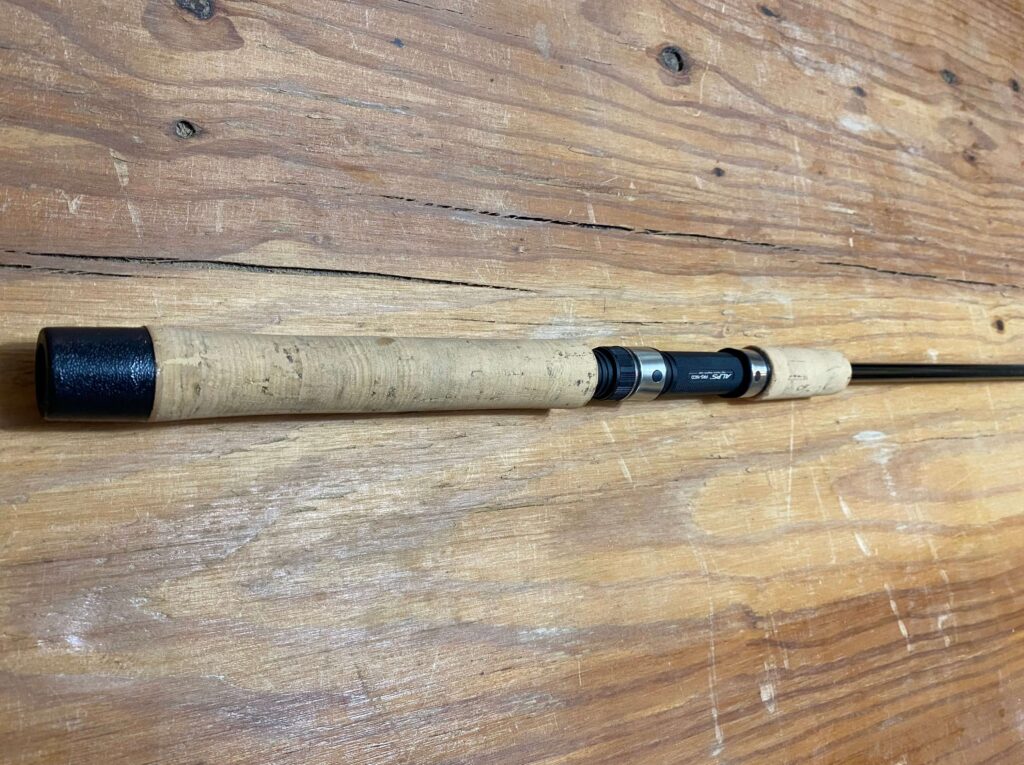
Thank you for reading and best of luck with your rod selection!
Sources:
“How to Choose the Right Rod”, rapala.eu
Have a reel good day,
– The Simple Fisherman
